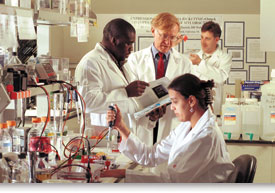The University of Texas Medical Branch at Galveston
 | |
| When The University of Texas Medical Branch at Galveston (UTMB) was established in 1891, many noted the benefit of the university's subtropical location. It was expected that a steady stream of tropical maladies would provide excellent opportunities for research and training. But it was only in 1987 that the university truly began to fulfill that promise. That year, a researcher from the University of North Carolina-Chapel Hill was tapped to lead the Department | 
Dr. David Walker, Carmage and Martha Walls Distinguished Chair in Tropical Diseases
|
| of Pathology. When he came to UTMB, David Walker was energized by the possibilities, convinced that the university could become a leading venue to study some of the world's most dangerous infectious agents. Almost by stealth, he began gathering talent: seasoned veterans in the fight against infectious disease and promising young investigators. He worked ceaselessly to cobble together disparate sources of funding, and saw to it that state-of-the-art facilities were constructed. |
In 1994, the university was named the first World Health Organization Center for Tropical Diseases in the United States. The next year, virologists Robert Shope and Robert Tesh decamped Yale for UTMB, and brought with them the World Reference Center for Arboviruses, the planet's most extensive collection of viruses transmitted by insects.
At that point, Dr. Walker knew UTMB's infectious disease research was at a critical juncture. The potential for the future, for new advances in the fight against such diseases as AIDS, malaria, hepatitis C, tuberculosis, rickettsioses, anthrax, yellow fever, West Nile virus, dengue fever, cholera and hantavirus hinged on the investment of philanthropic partners.
A 1995 gift to create the Carmage and Martha Walls Distinguished Chair in Tropical Diseases cemented that promise. This endowment, invested in the Long Term Fund, had a value of approximately $1.4 million at the year ended August 31, 2003. Dr. Walker was the deserving first recipient, in part because of his expertise in such diseases as Rocky Mountain spotted fever and typhus. Furthermore, in 1992, Walker and his colleagues helped blow the lid off the cover-up of history's deadliest anthrax epidemic - a man-made disaster in the former Soviet Union.
The Walls Distinguished Chair created momentum. For the first time, the value of private philanthropy in this relatively esoteric research endeavor became apparent. In its wake, other investments took hold.
Within a few years, the world began to notice. Feature articles in The New York Times, Science Magazine and Houston Chronicle trumpeted the expertise of the university's infectious disease researchers. D. A. Henderson, the central figure in the global fight against smallpox and the government's top bioterrorism advisor, has called UTMB "one of the best groups in the field of tropical medicine in the country, or for that matter, anywhere."
Today, the impact of the Walls' early investment is becoming even more evident. The university will soon bring on-line a biosafety level four (BSL4) facility to study viruses that require maximum containment. This will be the only full-size BSL4 laboratory at a United States academic health center.
In September 2003, the National Institute of Allergy and Infectious Diseases (NIAID) named UTMB one of eight institutions receiving grants to establish a Regional Center of Excellence for Biodefense and Emerging Infectious Diseases Research. UTMB is the lead institution in a $48 million effort (for which Dr. Walker serves as principal investigator) that involves 24 institutions from Texas and the surrounding four states. Three weeks later, the NIAID selected UTMB as the site of a $150 million National Biocontainment Laboratory, one of two national research facilities that will focus on emerging disease threats.